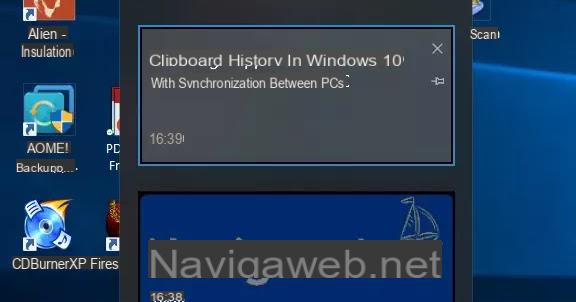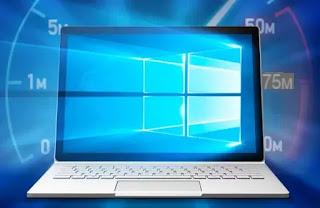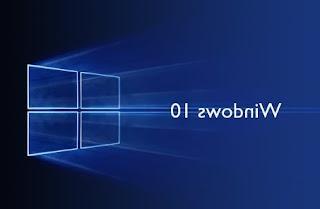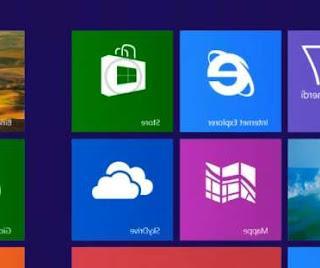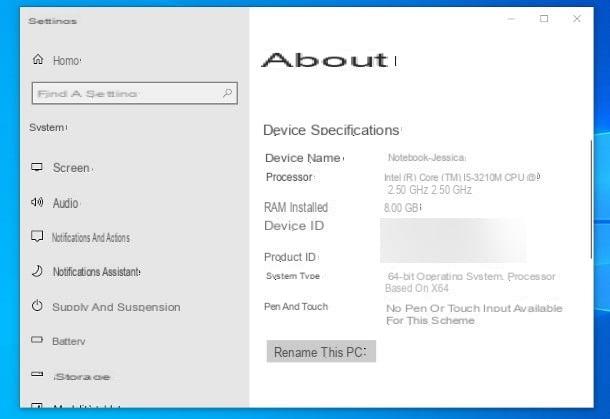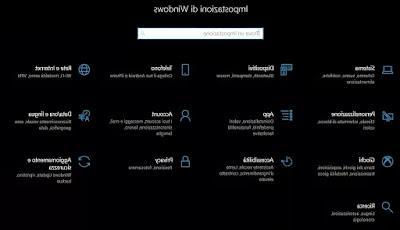 The first thing you notice after installing Windows 10 is the Settings menu, which opens as an application from the Start menu.
The first thing you notice after installing Windows 10 is the Settings menu, which opens as an application from the Start menu.The Windows Control Panel has remained, more or less, the same (although with a few less options than before as we will see) but it is in the Settings, real news for those coming from Windows 7, the most important change in Windows 10, which makes system configuration much easier than it is with the Control Panel options, often fragmented and hidden in "advanced" tabs that are not very evident and clear.
In this guide let's see a quick overview of all options in Windows 10 Settings (referring to the latest version, the one after the October update), trying to understand what they mean and where to find the most important ones.
First of all, to open Windows 10 Settings there are several possibilities.
The fastest is from the Start menu, by clicking on the Windows flag at the bottom left of the screen, finding the gear icon.
Settings can also be found quickly by pressing the right mouse button on the Start menu.
Alternatively, you can also access the settings by clicking on the notification icon at the bottom right, near the clock.
The Settings screen is divided into 13 categories and, more precisely: System, Devices, Telephone, Network and Internet, Personalization, App, Account, Date / time and Language, Games, Accessibility, Privacy, Update and security, Search.
To find the various options without looking for all the screens, you can use the search bar at the top right.
1) System
The system settings allow you to adjust and configure various options regarding the screen, audio, notifications, multitasking, storage, power and sleep and much more.
Among the most interesting and worth knowing options are:
- In Display, activate night mode to rest your eyes.
- In Notifications, you can turn off notifications and in Notification Assistant you can set a temporary "do not disturb" mode.
- Storage, you can activate the Memory sensor which facilitates the task of always keeping free space on the disk.
In Storage you can also see the space occupied by the various folders and find the largest files on your PC.
- Clipboard, allows you to activate copy and paste history and clipboard synchronization between various PCs.
2) devices
This is the section for adding and configuring printers, mouse, keyboard, scanner and other connected bluetooth devices.
From here you can disable Autoplay when inserting a USB stick or DVD and spelling correction.
Interestingly, in the Mouse section, the option to scroll through inactive windows by hovering over them with the cursor, which is one of the most convenient minor features of Windows 10.
Under Typing, you can enable or disable the Windows 10 handwriting spell checker, which only works with the Touchscreen keyboard.
3) Telephone
In this section there are options to connect your smartphone to Windows 10, so that you can easily transfer data and receive notifications on your computer.
4) Rete and Internet
All network and internet connection options are here.
You can configure a new Wifi connection, a remote connection, manage ethernet connections, set up a VPN or a Proxy and check the traffic consumed.
In Data consumption, you can see which apps consume the most internet bandwidth, useful in the case of a limited, non-flat connection.
In Hotspot, you can turn on the Windows 10 hotspot, so you can share your internet connection.
Proxy configurations, which were previously under Internet Explorer options, are now in this section of the Settings.
The properties of the network cards are also reachable from this section.
5) Customization
These are the desktop options, to change wallpaper, theme, fonts, colors, lock screen, start menu and taskbar.
We saw in another article how to customize the Windows 10 Start menu.
Under the Colors section it is possible to activate the dark theme for the background of the apps and folders, which is preferable especially for those who work in the evening.
For a complete overview of this set of options, I refer to the guide on how to customize Windows 10.
6) App
To choose the default apps to open certain files and to uninstall applications and programs you have to go to these Settings.
In particular, two options are interesting here: the first, under Apps and features, to hide the suggestions of new apps to install.
The second is the Startup section, which allows you to choose which applications to start automatically when the computer is turned on (previously it could only be done from the task manager, now also from here).
7) Account
From here you can choose whether to log in to Windows 10 with a local account or with a Microsoft account.
For those coming from Windows 7, I refer to the Windows 8 guide to understand what it means to log in to Windows with a Microsoft account.
From this section of options you can change your password, set a PIN, configure a domain or access to a corporate network, add other family users so that each can have their own custom options and set synchronization of settings.
This last screen of switches is used to make a backup of the main options of Windows 10 so that they can be found on other computers that are accessed with the same Microsoft account or to find them on the same PC in case of reinstallation.
8) Date and Language
This section contains, in addition to the date and time and language settings, also the voice recognition options.
Basically they are the configuration options of Cortana, the Windows 10 voice assistant that answers questions asked by voice, by speaking.
It is possible to configure the microphone from here.
9) Toys
The games section allows you to activate and configure the tool to record the screen during games, the one to photograph the screen and capture screenshots and the one to broadcast live.
Even if you are not playing, you can use the recording tool for other programs as well.
Under these settings, you can activate Game mode, to optimize PC performance automatically.
10 ) Accessibility
This is the tools menu for those with vision problems or problems using the mouse or other types of disabilities.
This is a really large section of options, among which are important ones to enlarge the text and icons on the screen, to set a different contrast and to use color filters.
From here you can activate the voice assistant, which reads out everything that appears on the screen.
11 ) Privacy
This is an important settings section for Windows 10 that allows you to configure privacy options.
The general options are the most important (already configured during the installation of Windows 10) in particular those on sending information to websites, to Microsoft and apps to improve the use of the PC.
Under this menu you can also activate or deactivate the Windows 10 activity history.
In another article the detailed guide to the Windows 10 privacy settings to disable the sharing of personal information.
12 ) Update and security
Windows Update in the Control Panel no longer exists and has been replaced with a settings section on this screen.
We have seen in another article how to configure Windows Update in Windows 10, block or uninstall updates.
The update options are different in Windows 10 Home, where the installation of updates is mandatory, compared to Windows 10 Pro, where the installation of updates in the advanced options can be delayed within a certain time.
It is also possible here to activate the Insider program (under For developers) to receive the new functions added to Windows 10 first.
In this section of options you can also configure the Windows Security settings, which includes Windows Defender, the internal antivirus of Windows 10.
There are also backup and restore options and license activation here.
As already explained in another article, from the Recovery menu it is possible to return to the previous version of Windows 10 within 10 days of installing an update, if there are problems.
Very important here is also the "Troubleshooting" section which collects all the automatic tools to solve typical network errors, printers, audio, Windows Update and various other things.
13 ) Research
This is a section added in the latest versions of Windows 10, rather sparse for now, which allows you to turn safe search on or off.
ALSO READ: Windows 10 tricks to make it better
Windows 10 Settings Guide








